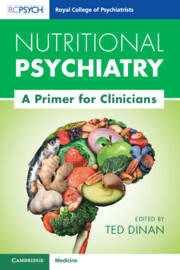Book contents
- Nutritional Psychiatry
- Nutritional Psychiatry
- Copyright page
- Contents
- Contributors
- Preface
- Chapter 1 Basic Principles of Nutrition
- Chapter 2 Diet and the Microbiome–Gut–Brain Axis
- Chapter 3 The Mediterranean Diet and Mental Health
- Chapter 4 Psychobiotics and Fermented Foods
- Chapter 5 Diet Interventions for Anxiety and Depression
- Chapter 6 Schizophrenia, Microbiota and Nutrition
- Chapter 7 Recognising the Importance of Nutrition for Child and Adolescent Mental Health
- Chapter 8 Old Age and Nutrition
- Chapter 9 Broad-Spectrum Micronutrients and Mental Health
- Chapter 10 Epigenetics
- Index
- References
Chapter 8 - Old Age and Nutrition
Published online by Cambridge University Press: 17 August 2023
- Nutritional Psychiatry
- Nutritional Psychiatry
- Copyright page
- Contents
- Contributors
- Preface
- Chapter 1 Basic Principles of Nutrition
- Chapter 2 Diet and the Microbiome–Gut–Brain Axis
- Chapter 3 The Mediterranean Diet and Mental Health
- Chapter 4 Psychobiotics and Fermented Foods
- Chapter 5 Diet Interventions for Anxiety and Depression
- Chapter 6 Schizophrenia, Microbiota and Nutrition
- Chapter 7 Recognising the Importance of Nutrition for Child and Adolescent Mental Health
- Chapter 8 Old Age and Nutrition
- Chapter 9 Broad-Spectrum Micronutrients and Mental Health
- Chapter 10 Epigenetics
- Index
- References
Summary
Psychogeriatric patients commonly present nutritional disorders due to a higher burden of multimorbidity, polypharmacy or psychopathology. Different nutritional disorders are associated with geriatric syndromes and adverse health outcomes in these patients. Epidemiological and clinical evidence justify a basic nutritional assessment for malnutrition in older mental health patients, given that mental and physical components are rarely unrelated. However, several professionals that care for older mental health patients do not have a nutritional training background. Beyond nutritional evaluation, diet counselling and supplement recommendation may be even harder for non-specialists. In this chapter, we suggest a quick, simple and basic nutritional assessment, we evaluate the literature on the relationship between anthropometric and nutritional measurement and mental disorders in older adults, and we review the best evidence regarding nutritional management for these patients. Additionally, we review potential biological pathways of the association between nutrition and late-life mental illness.
- Type
- Chapter
- Information
- Nutritional PsychiatryA Primer for Clinicians, pp. 134 - 151Publisher: Cambridge University PressPrint publication year: 2023



